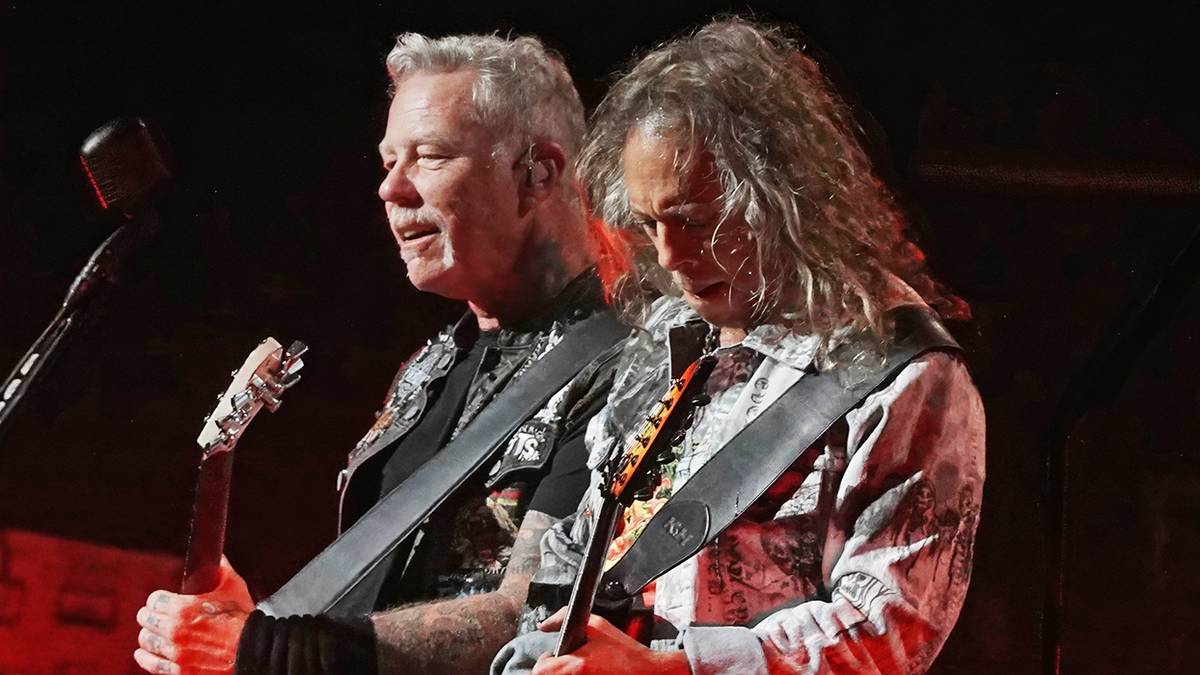Make sure to say your prayers, because Metallica said so. In 1981, frontman James Hetfield and Lars Ulrich teamed up to form Metallica. Together with Kirk Hammett and original bassist Ron McGovney, the quartet released their debut album Kill ‘Em All in 1983. Although the future ‘80s releases Ride the Lightning and Master of Puppets proved their worth in the world of heavy metal, it was their 1991 self-titled Metallica album (a.k.a. The Black Album) that catapulted them into global popularity. Although fans and critics consider the album one of Metallica’s most influential works, the band initially had doubts about the material — particularly one song that would prove pivotal in their career.
Released in 1991, Metallica’s “Enter Sandman” became a hit, reaching number 16 on the US Billboard Hot 100 and earning nine-times platinum for over 9 million copies shipped. Its eerie nightmare-inspired music video — a choice befitting of the song’s title — won Best Hard Rock Video at the 1992 MTV VMAs and earned nominations for Best Cinematography and Best Editing. A critically acclaimed staple among both fans and fellow musicians, the song has inspired six different covers on The Metallica Blacklist tribute album, including those by Mac DeMarco, Rina Sawayama, and Weezer.
However, Hetfield has his reservations with “Enter Sandman.” Luckily enough, his band members pushed him to move forward with the song. In an episode of Metallica’s Masterclass series, Hetfield gets personal about why he initially disliked “Enter Sandman”, and what drove him to release it anyway.
“I didn’t think Enter Sandman was such a great song. I think Lars [Ulrich] and Bob Rock said, ‘Go back. I challenge you to go back and work on it.’ And I did. And that line, that catchphrase, ‘We’re off to never, neverland,’ — what happens in your sleep, why do we have these certain nightmares? A lot of people could identify with that. Everyone has nightmares, and what do you do with them, and why do they show up?”
Although “Enter Sandman” has earned its praise among rock fans, Megadeth frontman Dave Mustaine noticed something familiar about the riff. Fans who have followed Metallica from the beginning will remember that Mustaine served as the band’s original guitarist from 1981 to 1983. Unfortunately, his short-lived career with Metallica came to an end when he was fired for his alcohol-induced temper, which would escalate into violence. Following Mustaine’s departure, Hammett stepped in as Mustaine’s replacement to record Kill ‘Em All.
On an episode of The Shawn Ryan Show, Mustaine not only emphasized that he was “unfairly dismissed” by Metallica, but also shared his personal observation of “Enter Sandman” (the actual title of the song that Mustaine meant to say was “Tapping into the Emotional Void”).
”Cause we [Megadeth] may not be as big as they [Metallica] are. Hell, their biggest song, ‘Enter Sandman’, go look up the band Excel right now. Look up their song — I think it’s something ‘Into The Unknown’. Pretty similar.”
On Metallica’s side of the story, guitarist Hammett recounted that he wrote the riff at “about 2 or 3 o’clock in the morning.” At that point, Hammet was listening to the Soundgarden album Louder Than Love. In a spur of inspiration and creativity, Hammett took his guitar and the riff for “Enter Sandman” instantaneously came out. Hammett’s original riff was further work shopped by Ulrich, suggesting Hammett to “repeat that first part four times,” — eventually shaping up to the catchy riff Metallica fans have grown to love.
In 1991, Metallica rocked Moscow’s Tushino Airfield in front of an estimated 1 to 1.6 million people, during a time when the Soviet Union was teetering on the edge of collapse. Just weeks earlier, a failed August Coup by hardline Communist officials attempted to overthrow Gorbachev, accelerating the USSR’s disintegration. Against this backdrop, Metallica performed “Enter Sandman” at the Monsters of Rock Festival, making history as the first open-air Western rock festival in Soviet history.
The massive crowd swelled from 300,000 to over a million, fueled by free entry and alcohol, while 11,000 troops and police struggled to maintain order. Violence broke out, dozens were injured, and over 48 arrests were made, but the chaos mirrored the social and political upheaval outside the festival grounds. Sikorsky helicopters hovered just above the crowd, adding more to the chaos.

